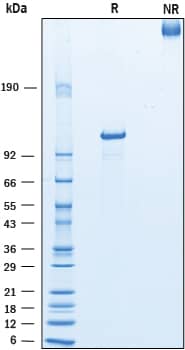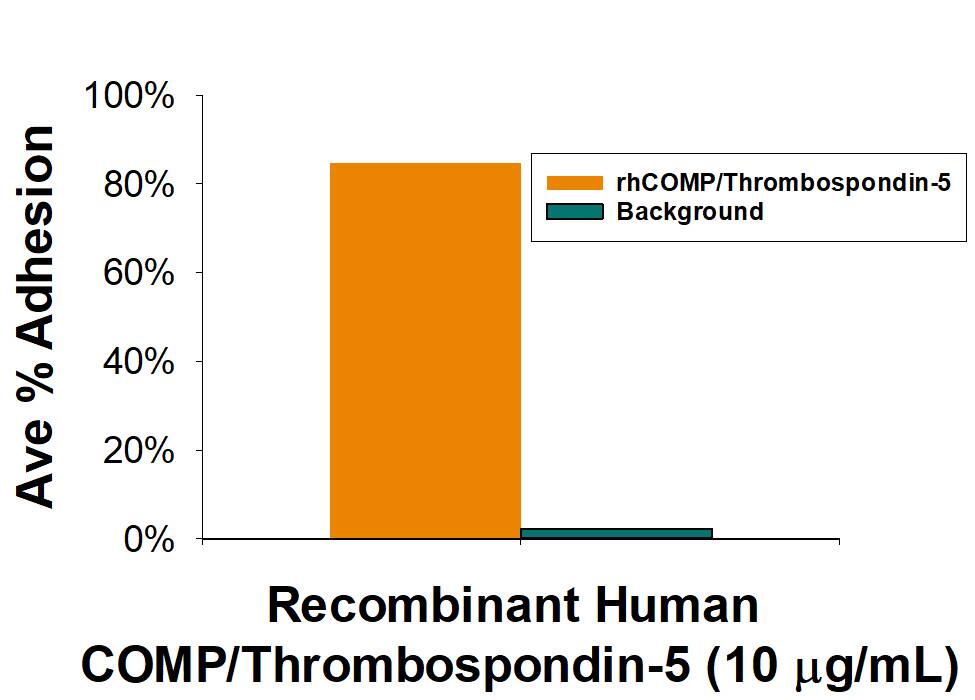Recombinant Human COMP His-tag Protein, CF
R&D Systems, part of Bio-Techne | Catalog # 3134-CPB

Key Product Details
Source
NS0
Accession #
Structure / Form
Disulfide linked homopentamer
Conjugate
Unconjugated
Applications
Bioactivity
Product Specifications
Source
Mouse myeloma cell line, NS0-derived human COMP/Thrombospondin-5 protein
Gln21-Ala757 (Ala256Arg), with a C-terminal 6-His tag
Gln21-Ala757 (Ala256Arg), with a C-terminal 6-His tag
Purity
>90%, by SDS-PAGE visualized with Silver Staining and quantitative densitometry by Coomassie® Blue Staining.
Endotoxin Level
<0.10 EU per 1 μg of the protein by the LAL method.
N-terminal Sequence Analysis
Gln21
Predicted Molecular Mass
81.8 kDa
SDS-PAGE
106-118 kDa, reducing conditions
Activity
Measured by its ability to induce adhesion of ATDC5 mouse chondrogenic cells.
Recombinant Human COMP/Thrombospondin‑5 immobilized at 10 µg/mL (100 µL/well) will induce more than 40% of ATDC-5 cell adhesion.
Recombinant Human COMP/Thrombospondin‑5 immobilized at 10 µg/mL (100 µL/well) will induce more than 40% of ATDC-5 cell adhesion.
Scientific Data Images for Recombinant Human COMP His-tag Protein, CF
Recombinant Human COMP His-tag Protein Bioactivity
Immobilized Recombinant Human COMP/Thrombospondin‑5 (Catalog # 3134-CPB) at 10 µg/mL (100 µL/well) induces more than 40% cell adhesion.Recombinant Human COMP His-tag Protein SDS-PAGE
2 μg/lane of Recombinant Human COMP/Thrombospondin‑5 was resolved with SDS-PAGE under reducing (R) and non-reducing (NR) conditions and visualized by Coomassie® Blue staining, showing bands at 106-118 kDa and 500 - 550 kDa, respectively.Formulation, Preparation and Storage
3134-CPB
| Formulation | Lyophilized from a 0.2 μm filtered solution in MOPS and NaCl with Trehalose. |
| Reconstitution | Reconstitute at 500 μg/mL in PBS. |
| Shipping | The product is shipped at ambient temperature. Upon receipt, store it immediately at the temperature recommended below. |
| Stability & Storage | Use a manual defrost freezer and avoid repeated freeze-thaw cycles.
|
Background: COMP/Thrombospondin-5
References
- Adams, J.C. and J. Lawler (2004) Int J. Biochem. Cell Biol. 36:961.
- Posey, K.L. et al. (2004) Int. J. Biochem. Cell Biol. 36:1005.
- Adams, J.C. (2004) Int. J. Biochem. Cell Biol. 36:1102.
- Mann, H.H. et al. (2004) J. Biol. Chem. 279:25294.
- Newton, G. et al. (1994) Genomics, 24:435.
- DiCesare, P. et al. (1995) J. Orthopaedic Res. 13:422.
- Efimov, V.P. et al. (1994) FEBS Lett. 341:54.
- Ozbek, S. et al. (2002) EMBO J. 21:5960.
- Chen, F.H. et al. (2005) J. Biol. Chem. 280:32655.
- Wislowska, M. and B. Jablonska (2005) Clin. Rheumatol. 24:278.
- Xiao, Y. et al. (2004) J. Gastroenterol. Hepatol. 19:296.
- Liao, Q. et al. (2003) Scand. J. Gastroenterol. 38:207.
- Kennedy, J. et al. (2005) Eur. J. Hum. Genet. 13:547.
- Hou, J. et al. (2000) Cell Calcium 27:309.
Long Name
Cartilage Oligomeric Matrix Protein
Alternate Names
EDM1, EPD1, MED, PSACH, Thrombospondin-5, Thrombospondin5
Gene Symbol
COMP
UniProt
Additional COMP/Thrombospondin-5 Products
Product Documents for Recombinant Human COMP His-tag Protein, CF
Product Specific Notices for Recombinant Human COMP His-tag Protein, CF
For research use only
